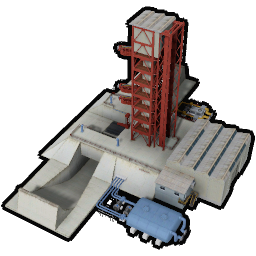Rocket Launch Pad: Difference between revisions
From Captain of Industry Wiki
m Footer Infobox |
Gruseligees (talk | contribs) added little description |
||
| Line 20: | Line 20: | ||
| Designation = Buildings | | Designation = Buildings | ||
}} | }} | ||
{{stub}} | {{stub}}The enables the launching build rocket in the [[Rocket Assembly Depot]] rockets to space! After a rocket is delivered and securely attached to the tower, it will be filled with the correct fuel for the rocket tier. | ||
{{Footer Infobox}} | |||
Rocket Tier 1 requires ([[Hydrogen]]+[[Oxygen]]) and Rocket Tier 2 needs (placeholder) | |||
The fuel needs to match with the current rocket typ and be connected to the launch pad. Fuel is never stored inside the launch pad for safety reasons. | |||
Water also needs to be connected since the takeoff requires a large amount of it for dampening of rocket exhaust shockwaves.{{Footer Infobox}} | |||
Latest revision as of 22:37, 22 June 2025

Enables launching rockets to space! After a rocket is delivered and securely attached to the tower, it will be filled with fuel based on the rocket type. This has to match with connected fuel to this tower. Fuel is never stored at the launch pad for safety reasons. Water also needs to be connected since the launch process requires a large amount of it for dampening of rocket exhaust shockwaves.
| Construction | |
| Workers | |
| Electricity | None |
| Maintenance | None |
| Footprint | 38x26* |
| Required Research | Rocket Assembly & Launch |
| Designation | Buildings |
- The enables the launching build rocket in the Rocket Assembly Depot rockets to space! After a rocket is delivered and securely attached to the tower, it will be filled with the correct fuel for the rocket tier.
Rocket Tier 1 requires (Hydrogen+Oxygen) and Rocket Tier 2 needs (placeholder)
The fuel needs to match with the current rocket typ and be connected to the launch pad. Fuel is never stored inside the launch pad for safety reasons.
Water also needs to be connected since the takeoff requires a large amount of it for dampening of rocket exhaust shockwaves.
| |
| |
| * Only available in the Supporter Edition | |